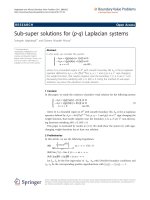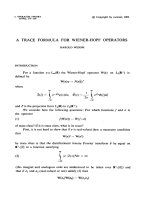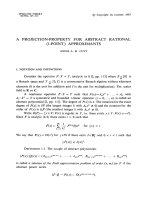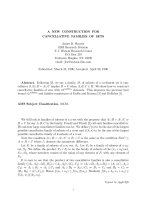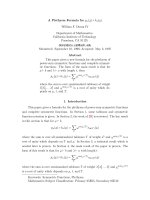Báo cáo toán học: "A Plethysm Formula for pµ (x) ◦ hλ (x) William F. Doran IV Department of Mathematics California Institute of Technology Pasadena, CA 91125" doc
Bạn đang xem bản rút gọn của tài liệu. Xem và tải ngay bản đầy đủ của tài liệu tại đây (211.8 KB, 10 trang )
A Plethysm Formula for p
µ
(x) ◦ h
λ
(x)
William F. Doran IV
Department of Mathematics
California Institute of Technology
Pasadena, CA 91125
Submitted: September 10, 1996; Accepted: May 2, 1997
Abstract
This paper gives a new formula for the plethysm of
power-sum symmetric functions and complete symmet-
ric functions. The form of the main result is that for
µ b and λ a with length t, then
p
µ
(x) ◦ h
λ
(x)=
T
ω
maj
µ
t
(T )
s
sh(T )
(x)
where the sum is over semistandard tableaux of weight
λ
b
1
λ
b
2
λ
b
t
and ω
maj
µ
t
(T )
is a root of unity which de-
pends on µ, t, and T .
1. Introduction
This paper gives a formula for the plethysm of power-sum symmetric functions
and complete symmetric functions. In Section 1, some tableaux and symmetric
function notation is given. In Section 2, the work of [D] is reviewed. The key result
in this section is that for µ b,
p
µ
(x) ◦ h
a
(x)=
T
ω
maj
µ
(T )
s
sh(T )
(x)
where the sum is over all semistandard tableaux T of weight a
b
and ω
maj
µ
(T )
is a
root of unity which depends on T and µ. In Section 3, a technical result which is
needed later is proven. In Section 4, the main result of the paper is proven. The
form of this result is that for µ b and λ a with length t
p
µ
(x) ◦ h
λ
(x)=
T
ω
maj
µ
t
(T )
s
sh(T )
(x)
where the sum is over semistandard tableaux T of weight λ
b
1
λ
b
2
λ
b
t
and ω
maj
µ
t
(T )
is a root of unity which depends on µ, t, and T .
Keywords: Symmetric Functions, Plethysm
Mathematics Subject Classification: Primary 05E05, Secondary 05E10
the electronic journal of combinatorics 4 (1997), #R14 2
1.1 Tableaux
A partition of n is a weakly decreasing sequence λ =(λ
1
≥···≥λ
l
) of positive
integers which sum to n. Either |λ| = n or λ n is used to denote that λ is
a partition of n. The value l is called the length of λ and is denoted l(λ). Let
[λ]={(i, j): 1 ≤ i ≤ l(λ) and 1 ≤ j ≤ λ
i
}⊂Z
2
. The set [λ]istheFerrers diagram
of λ and is thought of as a collection of boxes arranged using matrix coordinates.
A composition of n is a sequence α =(α
1
, ,α
l
) of positive integers which
sum to n. For notational purposes, let a
b
1
1
a
b
2
2
a
b
l
l
denote the composition
(a
1
, ,a
1
b
1
times
,a
2
, ,a
2
b
2
times
, ,a
l
, ,a
l
b
l
times
).
Also, given a composition α =(α
1
, ,α
l
), let α
t
denote the composition
(α
1
, ,α
l
, ,α
1
, ,α
l
)
where α is repeated t times.
A tableau of shape λ and weight (or content) α =(α
1
, ,α
l
) is a filling of the
Ferrers diagram of λ with positive integers such that i appears α
i
times. A tableau
is semistandard if its entries are weakly increasing from left to right in each row and
strictly increasing down each column. The Kostka number K
λ,µ
equals the number
of semistandard tableaux of shape λ and weight µ.If[ν]⊆[λ], let [λ/ν] denote the
skew-shape [λ] \[ν]. A filling of [λ/ν] with α
i
i’s is a skew-tableau of shape λ/ν and
weight α. A semistandard skew-tableau is defined similarly.
1.2 Symmetric Functions
The symmetric function notation in this papers closely follows that of Chap-
ter 1 in Macdonald [M]. Let Λ denote the ring of symmetric functions with rational
coefficients in the variables {x
1
,x
2
, }. Let s
λ
(x), p
λ
(x), and h
λ
(x) denote the
Schur symmetric functions, power-sum symmetric functions, and complete symmet-
ric functions respectively. The ring Λ has a bilinear, symmetric, positive definite
scalar product given by s
λ
,s
µ
=δ
λ,µ
.
When two Schur symmetric functions are multiplied together and expanded in
terms of Schur symmetric functions,
s
µ
(x)s
ν
(x)=
λ|µ|+|ν|
c
λ
µ,ν
s
λ
(x),
the resulting multiplication coefficients c
λ
µ,ν
are nonnegative integers. These coeffi-
cients are called Littlewood-Richardson coecients. See either Section I.9 of [M]or
Section 4.9 of [S]for details.
the electronic journal of combinatorics 4 (1997), #R14 3
Let f(x) and g(x) be symmetric functions. The plethysm of f(x) and g(x)is
denoted f(x
) ◦ g(x). A definition of plethysm is given in Section I.8 of [M]. The
plethysm results in this paper use a plethysm formula in [D]which is recalled in
Section 2. Plethysm has the property of being algebraic in the first coordinate.
Proposition 1.1. For all symmetric functions f
1
(x), f
2
(x), and g(x) the following
two identities hold.
(a) (f
1
(x)+f
2
(x)) ◦ g(x)=(f
1
(x)◦g(x))+(f
2
(x)◦g(x)).
(b) (f
1
(x)f
2
(x)) ◦ g(x)=(f
1
(x)◦g(x))(f
2
(x) ◦ g(x)).
While plethysm is not in general symmetric, the following is true.
Proposition 1.2. For any symmetric function f(x
) and positive integer n, p
n
(x)◦
f(x
)=f(x)◦p
n
(x).
Proofs of these propositions are given in Section I.8 of [M].
2. Formula for p
µ
(x) ◦ h
a
(x)
This section reviews some results in [D].
Definition: Given a semistandard tableau or semistandard skew-tableau T , i is a
descent with multiplicity k if there exists k disjoint pairs {(x
1
,y
1
), ,(x
k
,y
k
)}of
boxes in the Ferrers diagram of T such that the entry in each x
j
is i, the entry in
each y
j
is i +1, y
j
is in a lower row than x
j
for all j, and there does not exist a
set of k + 1 pairs of boxes which satisfy these conditions. Let m
i
(T ) denote the
multiplicity of i as a descent in T . Finally, the Major index of T , denoted maj(T ),
is sum of the descents with multiplicity. That is, maj(T )=
im
i
(T).
Given a semistandard tableau T whose weight has length b and a composition
α =(α
1
, ,α
l
)ofb, decompose T into a sequence of semistandard skew-tableaux
(T
1
, ,T
l
) by letting the shape of T
1
be those positions in T which contain 1
through α
1
, T
2
be those positions in T which contain α
1
+ 1 through α
2
, and so on.
The actual entries in T
i
are the entries of T but reindexed so they run from 1 to α
i
.
Definition: Following the notation of the previous paragraph, define the root of
unity
ω
maj
α
(T )
=
l
i=1
ω
maj(T
i
)
α
i
where the ω
k
= e
2πi/k
.
the electronic journal of combinatorics 4 (1997), #R14 4
Example 1: Consider
T =
11123
22234
345
.
Tis a semistandard tableau of shape (5, 5, 3) and weight (3, 4, 3, 2, 1). The descent
multiplicities are m
1
(T )=3,m
2
(T)=2,m
3
(T)=2,m
4
(T) = 1. Its Major index
is 17. Take α =(2,3). Then the decomposition of T is
T
1
=
1112
222
and T
2
=
1
12
123
The Major indices are maj(T
1
) = 3 and maj(T
2
) = 4. Finally, ω
maj
α
(T )
= ω
3
2
ω
4
3
=
−ω
3
.
The main result of [D]is the following.
Theorem 2.1. Let µ b, then
p
µ
(x) ◦ h
a
(x)=
SST T
wt(T )=a
b
ω
maj
µ
(T )
s
sh(T )
(x).
Here is a quick application of this formula. It is a generalization of Example 9(b)
in Section I.8 of [M].
Proposition 2.2. If b is prime power p
n
, then p
b
(x) ◦ h
a
(x),s
λ
(x)≡K
λ,a
b
(mod p).
Proof: By Theorem 2.1, p
b
(x) ◦h
a
(x),s
λ
(x)is a sum of K
λ,a
b
many terms where
each term is a p
n
-th root of unity.
One last result needed (Theorem 2.1 of [D]). This concerns an algorithm for
selecting the (x
j
,y
j
) pairs which contribute to the statistic m
i
(T ) for a given T.
Here is the algorithm.
Select an ordering σ of the α many boxes which contain an i.
Set j =0.
For k =1toαDo
Let x = σ(k).
If there are any boxes below x which contain i+1 and have not already been
selected as an y
j
Then
Increment j by 1.
Let x
j
= x.
Let y
j
be the right-most of these unselected boxes containing i +1.
End If
End Do
Algorithm 1.
the electronic journal of combinatorics 4 (1997), #R14 5
This algorithm clearly works when the ordering σ is to consider the i’s from
right to left in T. The surprising result is that this algorithm works for any choice
of σ.
Theorem 2.3. The above algorithm for determining m
i
(T ) works for all choices
of the ordering σ of the i’s.
It should be noted that the choice of pairs (x
j
,y
j
) may differ based on the choice
of σ, but the number of pairs does not differ.
3. A technical result
Definition: Given a semistandard skew-tableau T, define J(T) to be the semis-
tandard tableau obtained by the following algorithm, called Jeu de Taquin.
While T has skew-shape Do
Let λ/µ be the shape of T .
Let F be any outer corner of µ.
While F is not an outer corner of λ Do
If value of T to right of F is greater than or equal to the value below F
Swap F with the value below it.
Else
Swap F with the value to its right.
End If
End Do
End Do
Algorithm 2.
Example 2: Let
T =
123
122
123
.
One iteration of the inner loop is
F 123
122
12 3
,
1F 23
12 2
123
,
1223
12F
123
.
Here are the tableaux after each application of the inner loop along with the choice
of F for the next iteration:
F 1223
12
123
,
11223
F 22
13
,
F11223
122
3
,
111223
22
3
.
the electronic journal of combinatorics 4 (1997), #R14 6
It is clear that J(T ) is semistandard and that wt(J(T )) = wt(T ). However it
is not clear from the definition that this operation is well-defined. The choices for
the initial position of F in each iteration might effect the outcome of the algorithm.
But, it has been shown (see Section 3.9 of [S] for a proof) that for all choices of the
F’s, the resulting J(T ) is the same. The next result gives an important property
of the Jeu de Taquin operation. A proof is given in the proof of Theorem 4.9.4 of [
S].
Lemma 3.1. Given a semistandard tableau Q of shape η, the number of semistan-
dard tableaux T of shape λ/ν such that J(T )=Qequals the Littlewood-Richardson
coecient c
λ
ν,η
.
Another fact about Jeu-de-Taquin is that preserves descent multiplicities.
Lemma 3.2. Let T be a semistandard tableau whose weight has length b and let
α be a composition of b. Then m
i
(T )=m
i
(J(T)) for all i.
Proof: Suppose T → T
in one application of the inner loop of the Jeu de Taquin
algorithm. We want to show that m
i
(T )=m
i
(T
) for all i. If the swap of this kind
F j
k
→
j F
k
,
where k>j, then since no element has changed which row it occupies, it is clear
that all m
i
(T ) are unchanged. However, if the swap is of the other kind
F j
k
→
kj
F
where k ≤ j, then there are two possible problems: some (k, k + 1) pairs may have
been created, or some (k − 1,k) pairs may have been destroyed. Either of these
“problems” might alter the value of m
k
(T )orm
k−1
(T), respectively.
First, we show that any new (k, k + 1) pairs do not effect the value of m
k
(T ).
Let r be the row containing F in T . So, the possible new (k, k + 1) pairs in T
are
from the k which just moved into row r and the k + 1’s in row r + 1. Since T and
T
are semistandard, each of these k + 1 must have a k directly above them in both
T and T
. The key is apply Theorem 2.3 with the properly chosen ordering σ of
the k’s. The proper choice is to place the k’s in row r which have a k + 1 directly
below them (say from right to left) at the beginning of σ, then fill in all the other
k’s (again say from right to left). Now apply the algorithm to determine m
k
(T ) and
m
k
(T
). In both cases, the first group of k’s in row r with a k + 1 below them get
the electronic journal of combinatorics 4 (1997), #R14 7
matched with the k + 1 directly below them. Thus, all of the new (k, k + 1) pairs in
T
do effect the outcome of the algorithm since all of the k + 1’s get selected before
the algorithm can consider using one of these pairs. Therefore, m
k
(T )=m
k
(T
).
The proof that m
k−1
(T )=m
k−1
(T
) is similar. The (k − 1,k) pairs that get
destroyed in T
are from the k which moved into row r and the k − 1’s in row r.
Since T is semistandard, each of the k − 1’s in row r must have a k directly below
them in both T and T
. Order the k −1’s by placing the k −1’s in row r first and
other k −1’s later. The algorithm for determining m
k−1
(T ) and m
k−1
(T
) give the
same result.
Finally, these two lemmas are put together to prove a key technical result used
in the next section.
Theorem 3.3. Let |λ/ν| = n, β be a composition of n with l parts, and α be a
composition of l. Then
SSST T
sh(T )=λ/ν,wt(T )=β
ω
maj
α
(T )
=
ηn
c
λ
ν,η
SST T
sh(T )=η,wt(T )=β
ω
maj
α
(T )
.
Proof: By Lemma 3.1, Jeu-de-Taquin provides the bijection between the two sides.
By Lemma 3.2, ω
maj
α
(T )
is preserved under this bijection.
4. Formula for p
µ
(x) ◦ h
λ
(x)
Theorem 4.1. Given µ b and λ a where the length of µ is l and the length
of λ is t, let α = µ
t
and β = λ
b
1
λ
b
2
λ
b
t
. So, β is a composition of ab with tb parts,
and α is a composition of tb. Then
p
µ
(x) ◦ h
λ
(x)=
SST T
wt(T )=β
ω
maj
α
(T )
s
sh(T )
(x).
Proof: Proof by induction on t. The case t = 1 is Theorem 2.1. So assume the
theorem is valid when µ has length less than t. Let λ
∗
=(λ
1
, ,λ
t−1
). Now a
computation gives the desired result. Explanations of the steps are given after the
computation.
p
µ
(x)◦h
λ
(x)=
i
p
µ
i
(x)◦h
λ
(x) (1)
the electronic journal of combinatorics 4 (1997), #R14 8
=
i
h
λ
(x) ◦ p
µ
i
(x) (2)
=
i
(h
λ
∗
(x) ◦ p
µ
i
(x)) (h
λ
t
(x) ◦ p
µ
i
(x)) (3)
=
i
(p
µ
i
(x) ◦ h
λ
∗
(x))
i
(p
µ
i
(x) ◦ h
λ
t
(x)) (4)
=
SST T
1
wt(T
1
)=λ
b
1
λ
b
t−1
ω
maj
µ
t−1
(T
1
)
s
sh(T
1
)
(x)
SST T
2
wt(T
2
)=λ
b
t
ω
maj
µ
(T
2
)
s
sh(T
2
)
(x)
(5)
=
νab
s
ν
(x)
SST T
1
wt(T
1
)=λ
b
1
λ
b
t−1
ω
maj
µ
t−1
(T
1
)
c
ν
sh(T
1
),η
SST T
2
sh(T
2
)=η,wt(T
2
)=λ
b
t
ω
maj
µ
(T
2
)
(6)
=
νab
s
ν
(x)
SST T
1
wt(T
1
)=λ
b
1
λ
b
t−1
ω
maj
µ
t−1
(T
1
)
SST T
2
sh(T
2
)=ν/sh(T
1
),wt(T
2
)=λ
b
t
ω
maj
µ
(T
2
)
(7)
=
νab
s
ν
(x)
SST T
3
sh(T
3
)=ν,wt(T
3
)=β
ω
maj
α
(T
3
)
(8)
(1) Apply Proposition 1.1(b). (2) Apply Proposition 1.2. (3) Apply Proposi-
tion 1.1(b). (4) Apply Proposition 1.2. (5) Apply the induction hypothesis. (6)
the electronic journal of combinatorics 4 (1997), #R14 9
Multiply the Schur symmetric functions and collect the terms which contribute to
s
ν
(x). (7) Apply Theorem 3.3. (8) Combine T
1
and T
2
to form T
3
by first reindexing
the values in T
2
to run from b(λ
1
+···+λ
t−1
)+1 to b(λ
1
+···+λ
t
) and then place T
1
inside the reindexed T
2
. Notice that under this bijection ω
maj
µ
t−1
(T
1
)
ω
maj
µ
(T
2
)
=
ω
maj
α
(T
3
)
.
Example 3: Let µ = (2) and λ =(2,1). Then α =(2,2) and β =(2,2,1,1).
The semistandard tableaux T with weight β and ω
maj
α
(T )
are given in Table 1.
So, p
(2)
(x) ◦ h
(2,1)
(x)=s
(6)
(x) − s
(5,1)
(x)+2s
(4,2)
(x) − 2s
(3,3)
(x) − s
(4,1,1)
(x)+
s
(2,2,2)
(x)+s
(3,1,1,1)
(x) − s
(2,2,1,1)
(x).
References
[D] W. Doran, A New plethysm Formula for Symmetric Functions, J. of Alg.
Combin., submitted.
[M] I. Macdonald, “Symmetric Functions and Hall Polynomials,” 2nd ed., Claren-
don Press, Oxford, 1995.
[S] B. Sagan, “The Symmetric Group: Representations, Combinatorial Algo-
rithms, & Symmetric Functions,” Wadsworth & Brooks/Cole, Pacific Grove,
CA, 1991.
the electronic journal of combinatorics 4 (1997), #R14 10
T ω
maj
(2,2)
(T )
T ω
maj
(2,2)
(T )
112234 1
1122
3
4
−1
11224
3
1
1124
2
3
−1
11223
4
−1
1123
2
4
1
11234
2
−1
112
23
4
1
1122
34
1
112
24
3
−1
1124
23
−1
114
22
3
1
1123
24
1
113
22
4
−1
1134
22
1
11
22
34
1
112
234
1
112
2
3
4
1
113
224
1
11
22
3
4
−1
Table 1: Semistandard Tableaux of Weight (2, 2, 1, 1)


